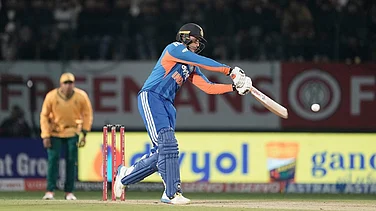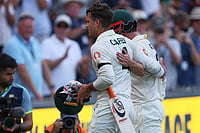Two days before India played England in Durban, fast bowler Andrew Caddick chose to give an analysis of the Indian team, not knowing that such a thing was as much an applied science as the Bible's first chapter. Caddick said that the Indian batting line-up doesn't impress him, that Sachin Tendulkar's 150 against Namibia was flawed, that the Indians have not played better cricket than England in the tournament, and by that derivation he will be in the winning team. As it happens with such simple truths about India, he was right before the match and wrong afterwards. Under the floodlights, before an overwhelming number of Indian supporters who had come from many parts of the world to drink and search for any excuse to drink more, Saurav Ganguly's men gave them plenty. Certainly in excess of merely logical expectations. For the first time in the World Cup, Indians looked like a side that has come from a truly cricket-mad nation. From the depths of mediocrity where fans, observers and commentators till recently threw rubbish in, the heroes are now rising, though one at a time. Apart from making the mistake of letting rationality interfere with an overview of the Indian team, Caddick also presumed that Sachin doesn't read papers. But he always seems to when something unkind is said about him. For being brushed aside as no great threat, he targeted English bowlers with pre-determined pulls and embarrassingly easy pushes.
But what has melted the familiar caution in the surging Indian optimism today is, very strangely, not the return of batting geniuses. It's the bowling and fielding that have quietly grown in the shadow of a more famed batting list throughout the World Cup, and exploded in Durban to claim their rightful place as more than just support cast. Ashish Nehra, who touched 148 kmph consistently against Zimbabwe, was unplayable against England, though slower that night. On his way to bag the best Indian bowling figures ever in the Cup's history, he was like one of those indoor bowling machines with a small human glitch, set at over 140 kmph down a mean line.
After Indian seamers made English batsmen meet air most of the time, Kaif's almost unnatural run-out of Knight which was difficult to fully deconstruct even in replays, Sehwag's stunning catch of a Flintoff rocket, and a generally spectacular fielding performance of the Indians, vanquished English captain Nasser Hussain walked into the mandatory post-match press conference. He carried with him the humour of an experienced man who knows that while playing against India there are days when they are the statue and there are days when they are the pigeon. Someone asked him if the English team had turned "complacent" after its big victory against Pakistan. This is a sort of question captains are normally asked and the right answer is, "there is no room for complacency at this level of the game". But Hussain said, "yeah" with a long drawl. "We were so complacent. This match was of no importance to us. We'd like to lose to India all the time." Continuing to de-intensify the funeral process, he said when asked to explain why he didn't seem to hear what Ganguly had said after winning the toss, "There was a lot of noise on the ground. I didn't get whether he said he wanted to bat or bowl. I figured it out when he spoke into the mike to...Ravi Shastri or whatever you call him." But even in that mood, he turned a bit serious and granted that Indian seamers "bowled superbly. They used the conditions better than us. The balls just zipped off the wicket. Nehra is quicker than we thought. He certainly is quicker than he was when he toured England".
Nehra attributes his new-found pace to "four-to-five months of fitness training". The shy Delhi boy who never knows what to say to strangers is not one of those fast bowlers who inexplicably stop in the track and tell a batsman that he is actually fatherless.However, his spitting deliveries, spawned in a brisk run-in and smooth action, is fast making him one of the most offensive bowlers in this Cup. The 24-year-old left-armer who is, as suspected, "most impressed with Wasim Akram", was given the new ball in the match against Namibia. But as Saurav told journalists, "We wanted to know what he could do with the new ball. It looks like he falls with it". Nehra bowled just one ball against Namibia. He slipped and fell down while on his way to deliver the next, making him leave the field for the rest of the match. He had to go through a fitness test before the match against England. "More than anybody else, he wanted to play," says Ganguly. "He worked on it and passed the fitness test." Nehra, who was still in protective bandage while playing England, assures you that "it was just a swollen ankle". Seemingly prone to trouble, Nehra threw up during his last over against England. "It was just the banana I ate before the over." Like most men who talk less, there's some sort of silent steely strength in him, an aura of self-taught determination that was first evident against Zimbabwe when he fielded like a demon near the boundary ropes.
Nehra, along with the other bowlers, has made this side look like one of the most efficient in this World Cup. At the time of writing, no team has scored more than 200 against this attack, nor has any team completed its 50 overs against it (that Australia didn't have to is a painful hurt that is beginning to heal fast). It's becoming clear in South Africa that the seamers are greatly aided in the initial overs. Early wickets have fallen in most matches. With conditions and general talent making Indian seamers finally look like match-winners, the question is—does Anil Kumble have a place in this side? With India clearly deciding against two spinners, Kumble is having to sit out alongside minors like Parthiv Patel. Ganguly's practised reply to queries about Kumble is: "It's always a tough choice to drop Anil Kumble but we don't have any other option." India may not go in with five accomplished bowlers or with just two seamers. So, though Kumble returned with figures of 32 for 4 against Holland in 10 overs and an impressive 24 for 1 in 7 overs against Australia, his only chance to get back into the side for the rest of the World Cup will be at the expense of Harbhajan Singh. Suddenly in the bowling department there seems to be an embarrassment of riches. But that's only because Indians have made up their minds about going in with a bowler short, hoping that spares like Ganguly, Sachin, Sehwag and Mongia will contain at one end. This will be a fatal error on a good batting track against a strong side. But Ganguly insists that he doesn't feel he misses a fourth seamer. "No" was his brief, rude reply in the post-match conference in Durban. That was because he was that fourth seamer against England and the most expensive, conceding 34 runs in his 6 overs. With a pace that is, as Boycott once said, "pleasurable if he hits your groin", Ganguly will not be able to weave the magic in South Africa that he once wove in Canada and other homes of ice hockey.
There is a very simple solution to this unnecessary predicament. Send in Sanjay Bangar with a ball instead of the towel. Bangar's inclusion will not disturb the Indian need for the 7-batsmen reassurement. This will mean Dinesh Mongia has to sit out. Except for his immediate family, nobody else will weep. His 32 against England came at a strike rate of less than 50 per cent. Except against Holland, he has agonised himself and others who have paid to watch a sport. But his captain is right behind him. Even after Mongia's English odyssey, Ganguly says: "He will get his confidence back soon. He will make runs." The mystery of Indian cricket is that some players are on the bench for not entirely cricketing reasons. It's hard to believe that there was a grain of cricketing brain in the decision to ask V.V.S. Laxman to stay at home because Mongia could do the job better. Laxman's omission from the squad safely comes under the crying over spilt milk category, so his is a sad story that is futile to pursue. But if the Indian dressing room is a democracy, despite some regal blood in the system, Bangar will play in this World Cup. John Wright will want him to.
It will be the weak links in the team that will for certain create atrocious dips in the next few weeks. Mongia robbed India of at least 20 runs in the match against England. In a close encounter, that's the difference between victory and defeat. For the moment, there is what is called 'turnaround' by impassionate observers who never believed this Indian side will be in the Super Six. But there is no such point when one can say, 'Indians are peaking'. There will be no neat 45-degree climb to glory. Perhaps it's only appropriate that the graph of India's impending fortunes will look somewhat similar to that of the erratic beatings of a billion overworked hearts.
Swing Thing
Back-to-back victories in SA and the nation's collective optimism is surging. Indian cricket's now sporting a new face: a fearful pace battery.

Swing Thing
Swing Thing
Published At:
- Previous Story
 Bournemouth Vs Burnley Preview, English Premier League: Match Prediction, Players To Watch – All You Need To Know
Bournemouth Vs Burnley Preview, English Premier League: Match Prediction, Players To Watch – All You Need To Know - Next Story
MOST POPULAR
WATCH
MORE FROM THE AUTHOR
×

















